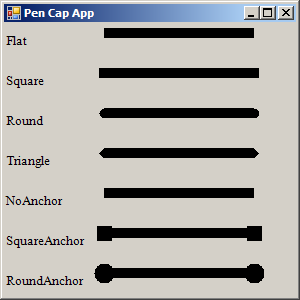Line Cap style

namespace PenCapApp
{
using System;
using System.Drawing;
using System.Drawing.Drawing2D;
using System.Collections;
using System.ComponentModel;
using System.Windows.Forms;
using System.Data;
public class Form1 : System.Windows.Forms.Form
{
public Form1()
{
InitializeComponent();
}
private void InitializeComponent()
{
this.AutoScaleBaseSize = new System.Drawing.Size(5, 13);
this.ClientSize = new System.Drawing.Size(292, 273);
this.Text = "Pen Cap App";
this.Resize += new System.EventHandler(this.Form1_Resize);
this.Paint += new System.Windows.Forms.PaintEventHandler(this.Form1_Paint);
}
static void Main()
{
Application.Run(new Form1());
}
private void Form1_Paint(object sender, System.Windows.Forms.PaintEventArgs e)
{
Graphics g = e.Graphics;
Pen thePen = new Pen(Color.Black, 10);
int yOffSet = 10;
Array obj = Enum.GetValues(typeof(LineCap));
for(int x = 0; x < obj.Length; x++)
{
LineCap temp = (LineCap)obj.GetValue(x);
thePen.StartCap = temp;
thePen.EndCap = temp;
g.DrawString(temp.ToString(), new Font("Times New Roman", 10),
new SolidBrush(Color.Black), 0, yOffSet);
g.DrawLine(thePen, 100, yOffSet, Width - 50, yOffSet);
yOffSet += 40;
}
}
private void Form1_Resize(object sender, System.EventArgs e)
{
Invalidate();
}
}
}
Related examples in the same category